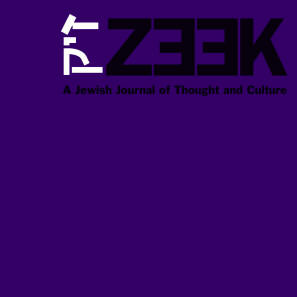 June 06
June 06
Goldbergers and Cheeseburgers: Food and Particularism among American Jews
Leah Koenig
 1. Bacon and Manischewitz
1. Bacon and Manischewitz
My brother, both a carnivore and contrarian from day one, adored the crispy, fat-streaked bacon he sampled surreptitiously in friends’ kitchens. Bacon was not allowed in my family’s home - perhaps no surprise, considering we were Jewish. But my mother’s family - Jewish Russian immigrants who settled in the Midwest - had abandoned the laws of kashrut when she was only 12. It wasn't the treyfkeit, insisted my mother (who holds a Masters of Public Health and was the champion of our household’s nutrition campaign), but that bacon was “unhealthy” - high cholesterol, clogged arteries, saturated fat. Perhaps my mother was sublimating and actually had some internal aversion to bacon that had formed during her first 12 years of life. But if that was the case, she never explicitly said so. So, while my brother tried to coax our mother to reconsider her position, the house remained free of the fatty breakfast meat he craved. The only times she relented were during our family’s yearly vacations to Las Vegas. Standing in line at one of Vegas’ hedonistic buffets, or sitting in a family-style coffee shop and casino, my brother was permitted to order whatever he wanted. And so he did: a plate of bacon, straight up and defiantly dripping with savory grease. He would sit and eat, blissed out on taboo, savoring his breakfast with holy reverence.
I recently told this bacon story in front of a small audience at a pluralistic Jewish conference. My hope was to provoke a discussion about eating, family, and the various ways we experience and negotiate our multiple traditions (Jewish, American, Israeli, etc.) through our food choices. I wanted to draw out some of the stories that make the Jewish community beautifully particular - both internally and as a part of the larger world. But before I got past the second line of my story, I was sternly interrupted by a woman who said, “Oh you can’t talk about bacon like that – it’s Shabbos!” Just as accidentally cutting meatloaf with a butterknife contaminates not only the food but the knife itself, so it seemed my mention of bacon treyfed up this woman’s entire experience.
I was irritated, but not particularly surprised. Food – what we choose to eat (or not eat), what we share with friends, and what we feed to our families – is a vital aspect of many cultures, and can serve as a point of connection to family memory, lineage, and cultural inheritance. And it is certainly central within the Jewish tradition, where its significance extends far beyond nutrition into culture, identity, and community. In her book Miriam’s Kitchen, for example, Elizabeth Ehrlich describes the wisdom and stories her mother-in-law shared with her in the kitchen - interactions, which, together with the richly-storied recipes that Miriam taught her became Ehrlich’s entry point into a meaningful Jewish life that she had rejected years before. So of course people worry when it's treyfed up.
Food is also a primary expression of cultural uniqueness, in that it creates a common culinary palette and set of shared taste memories that can serve as a source of distinction or pride. Case in point: Last summer, a friend of mine brought a bottle of Manischewitz wine to a party of both Jews and non-Jews. It was not long before a crowd of usually-closeted Jews circled around this friend, excitedly sharing their adoration for and horror stories about the syrupy Jewish wine. The interaction was brief, and isolated from the otherwise integrated party, but it provided a momentary sense of belonging and connection for the Jews in the room. Perhaps these types of interactions explain why even with the rising secularism in American Jewish life (especially outside of New York City), some Jews still seem to cling to food traditions – metaphorically, if not halachically.
In fact, this is not a new phenomenon. In The Book of Jewish Food, Claudia Roden describes the term fressfroemigkeit, or “culinary Jew,” which was used in 19th century Europe to describe assimilated Jews who expressed their Jewishness solely through eating traditional Jewish food on holidays. Similarly, some of today’s less traditionally observant Jews refer to themselves (only half-jokingly) as “bagel and lox Jews.”
Why are "culinary Jews" so common? On the one hand, food is easy. Regardless of whether one decides to affiliate with traditional Jewish institutions (e.g. synagogues or movements), the desire for the comfort of group identity and cultural significance can often be satisfied reliably, if temporarily, by a hot bowl of matzoh ball soup. On the other hand, despite its apparent easiness, food is a meaningful bond. Eating together is the consummate social act, and a shared vocabulary (e.g., recipes) can serve as a link between traditionally observant and alternatively or non-observant Jews (at least in theory). The chewy warmth of a fresh challah, the buttery crumble of rugelach, or a hunk of rich, raisin-dotted kugel carry within them layers of personal and collective Jewish memories that extend beyond denominational lines.
Whatever its sources, culinary Judaism is not a simple phenomenon. In fact, behind the seemingly innocuous food practices of neither-assimilated-nor-conventionally-affiliated Jews lies a complex history of food and particularism, and uncertain questions for the future.
2. Post-Assimilation, Kosher-Style
America’s Jewish grandparents (many of whom immigrated to the US from Europe in the late 19th and early 20th centuries) endeavored to blend in to their new surroundings. Fearing the discrimination they faced in Europe and seeking acceptance in their new home, many chose to modify or abandon their cultural particularities and adopt the values and trends that mimicked those of the dominant Protestant society. In her book Wonders of America: Reinventing Jewish Culture 1880-1950, Jenna Joselit explains how these changes were particularly evident in the choices these new American Jews made around food and other domestic rituals: in their homes, Jewish mothers began to focus less on traditional European Jewish recipes and the laws of kashrut, and more on their children’s health and success in America. Of course not all immigrant Jewish families exchanged Jewish cooking for American food trends, but in their struggle to integrate and thrive in American society, many of their traditional practices were either muted or completely abandoned. Ehrlich’s anecdotes in Miriam’s Kitchen reinforce Joselit’s argument:
[Our immigrant grandmothers] wanted their children to be of the New World, even as they fought the confusing temptations of New World streets. They wanted their children to have the best, even if it was unkosher, treyf. I don’t mean that only as a metaphor. Somewhere around 1940, my Brooklyn grandmother, listening to a nutritionist on the radio, heard that bacon had special disease-fighting properties…Thus my aunt insists from time to time her mother pressed coins in her hands, urging a lunch of BLT on the Brooklyn College Campus.
Of course, the urge to assimilate strongly affected the American-born children of the Jewish immigrants. These children, who heard the stories of their parents’ religious persecution in Europe, and experienced discrimination themselves, were compelled to assimilate to an even greater degree into their surrounding American culture. My mother’s family serves as a telling example. Her grandmother, who was born and raised in Russia, kept a kosher kitchen.  When she moved with her family to America (first Brooklyn and then to Minneapolis), she insisted on upholding kashrut standards and continued to make many of the recipes she was taught as a young woman. She also resisted learning English. Yet when her daughter (my grandmother), got married and had children of her own, she discarded the laws of kashrut when the kosher butcher in town closed shop. Traditional foods were reserved for Pesach seders or family simchas, whereas everyday cooking was almost unidentifiable as Jewish. Like many other Jews, however, my bubbe did retain a nostalgic affection for “kosher style” food and delicatessens, which implied a sense of “kosher quality,” but came complete with Swiss cheese and corned beef Reuben sandwiches. As the third link in this chain, my mother’s kitchen fully reflects the trend of assimilation. She married my father (who is not Jewish), and raised me and my brother in a Jewish, but decidedly non-kosher household. As mentioned before, bacon was not allowed in our kitchen. But tall glasses of skim milk accompanied nearly all of my family’s chicken, steak (and occasionally lobster) dinners.
When she moved with her family to America (first Brooklyn and then to Minneapolis), she insisted on upholding kashrut standards and continued to make many of the recipes she was taught as a young woman. She also resisted learning English. Yet when her daughter (my grandmother), got married and had children of her own, she discarded the laws of kashrut when the kosher butcher in town closed shop. Traditional foods were reserved for Pesach seders or family simchas, whereas everyday cooking was almost unidentifiable as Jewish. Like many other Jews, however, my bubbe did retain a nostalgic affection for “kosher style” food and delicatessens, which implied a sense of “kosher quality,” but came complete with Swiss cheese and corned beef Reuben sandwiches. As the third link in this chain, my mother’s kitchen fully reflects the trend of assimilation. She married my father (who is not Jewish), and raised me and my brother in a Jewish, but decidedly non-kosher household. As mentioned before, bacon was not allowed in our kitchen. But tall glasses of skim milk accompanied nearly all of my family’s chicken, steak (and occasionally lobster) dinners.
Unlike our ancestors, today’s American Jews enjoy unprecedented levels of acceptance. In America, our generation lives without the daily fear of being directly discriminated against for our Jewish background or practices. And interestingly, over the last few decades, Jews have gained some global recognition for our cultural (and culinary) uniqueness. This cultural acceptance has created a far more comfortable environment for Jews to claim their Jewishness – both for themselves and in public settings. To some degree this reclamation is religious, as more opportunities for pluralistic and non-dogmatic Jewish ritual and prayer are emerging in cities and communities across America. But it is largely cultural. Jews – myself included – are beginning to embrace the Jewish roots that our grandparents and parents abandoned out of fear and a desire to fit in, but without the traditional religious trajectory of a baal tshuvah or organizational affiliations of a mainstream Jew. They are increasingly seeking meaningful ways to integrate Jewish life and tradition into their otherwise secular lives – many through culture or kitsch, and some (though fewer) through increased observance of Jewish rituals.









